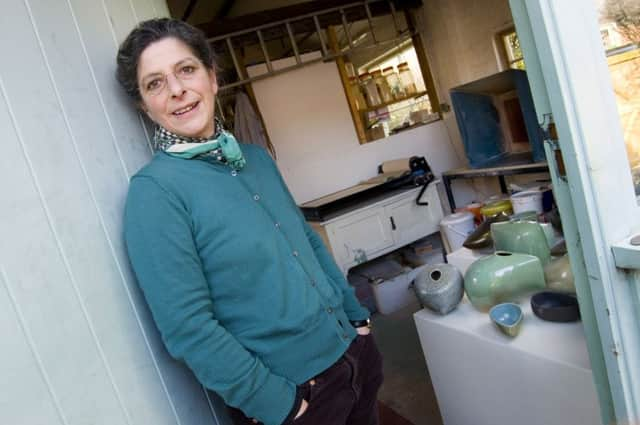Wheel turns back to craft


Every piece is an original, a one-off made with care and creativity by a named designer. But there is something else and it may sound “hippy dippy” to the uninitiated.
Those who collect and treasure handmade pots often call it “soul”, while others describe it as “an energy”.
Advertisement
Hide AdAdvertisement
Hide AdWhatever “it” is has helped contribute to a ceramics renaissance and a new appreciation for the skill of the potter.
Evidence of this can be seen in galleries across the country, including York Art Gallery, which has just opened the Centre of Ceramic Art. CoCA is a new resource highlighting the gallery’s collection of British studio ceramics, which is the largest in the UK.
There is also an increasing number of fairs and exhibitions devoted to the craft.
The latest is the prestigious Ceramic Art York, a new three-day selling fair of contemporary British studio ceramics at the city’s Museum Gardens between September 11 to 13. Among the 50 exhibitors is Ruth King, one of Britain’s pre-eminent salt glaze potters.
Advertisement
Hide AdAdvertisement
Hide AdYorkshire-based Ruth, who is Chair of Ceramic Art York and a council member of the Craft Potters Association, says: “Studio ceramics offer the perfect antidote to big business, globalisation and poorly made mass-produced goods transported across the world. In other words, impersonal objects with no “soul”. Everyone uses pots. Buying handmade ceramics is the most accessible and affordable way for people to welcome something unique into their lives and also support traditional skills and craftspeople.”
Lisa Hammond, a Fellow of the CPA and founder of the Adopt A Potter charitable trust, which funds apprenticeships, makes functional soda glaze pots inspired by Mino pots of Japan. She agrees that there has been a noticeable interest in handmade pottery.
“Perhaps people are getting tired of cheap mass-produced work and are looking for something that will enhance their cooking and eating experience that also looks beautiful on the shelf and is worth taking care of.”
Richard Phethean, chair of the Craft Potters Association, believes that affordability is also part of the attraction.
Advertisement
Hide AdAdvertisement
Hide Ad“Collecting ceramics is an affordable pursuit compared to collecting paintings and it has certainly grown steadily year-on-year. High quality shows such as Ceramic Art London and York are attracting buyers from far and wide. The numerous regional pottery festivals and events are all places where avid collectors can purchase pieces directly from the makers. Contemporary Ceramics, the CPA’s own central London gallery, is a mecca and there is an ever-growing number of art galleries that stock good quality pottery and ceramics, while giving important exposure to new makers.”
Investment potential is sound. Surviving pieces from the last great renaissance in studio pottery, in the 1960s and 70s, are now very collectable.
Demand for these and for new work is climbing but there is a potential stumbling block. According to Richard, there could be a chronic shortage of potters in the future.
He says: “For 13 years, I have been a resident potter in an independent Quaker school and I have never had any difficulty in getting children to appreciate the magic of clay. My intensive short courses with adults are filled with amateur potters desperate to learn how to improve their skills.
Advertisement
Hide AdAdvertisement
Hide Ad“Sadly, the opportunities to pursue pottery and ceramics at school or university have reduced dramatically in recent years and, as the population of potters like me ages, the chance for vocational training in a studio has also dwindled.”
The Craft Potters Association is committed to reversing this trend and has an education programme designed to support new makers, the “Adopt a Potter” scheme and a charitable trust that gives grants to makers trying to set up new studios.
However, the biggest boost could come from TV this autumn. BBC2 is about to launch the The Great British Pottery Throw Down, a Bake Off-style challenge.
Presenter Sara Cox will be joined by renowned potters, Keith Brymer-Jones and Kate Malone. Each week 10 contestants will create a “Main Make”, where they translate a slab of clay into glazed glory, culminating in the reveal straight from the kiln.
Advertisement
Hide AdAdvertisement
Hide AdSarah Cox says: “Clay, mess, passionate potters and the team behind Bake Off. What’s not to love? There’s something really raw and exciting about grabbing a lump of clay and creating something unique out of it.”
Richard Phethean hopes it will be a hit: “We hope this will renew interest in the craft nationally and be a shot in the arm for all those of us who earn a living by selling or teaching pottery and ceramics.”
Ceramic Art York is at the Museum Gardens, York, September 11 to 13, and features 50 leading British makers of studio ceramics. There will also be a programme of talks, discussions, demonstrations and films and a chance to buy directly from makers. Entry includes a full colour catalogue and tickets are £8, www.ceramicartyork.org.